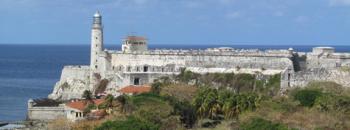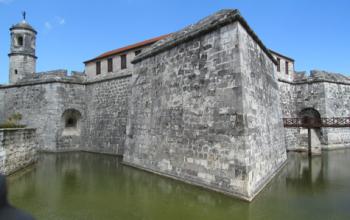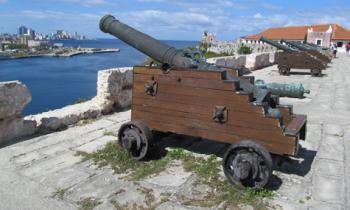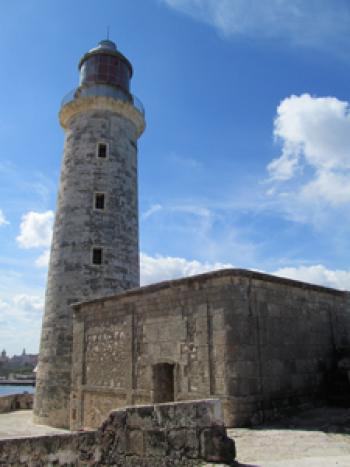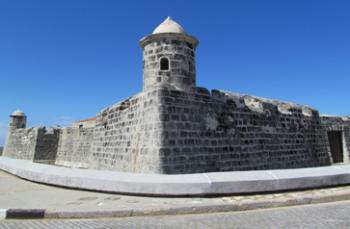Quartet of Havana fortresses
This item appears on page 54 of the February 2018 issue.
Quartet of Havana fortresses
Havana’s long, rich history stretches back to the time of Christopher Columbus. 2019 will mark the 500th anniversary of the founding of this city on the island of Cuba in the Caribbean. Because of its strategic location, it is not surprisingly a city especially rich in fortresses. Four of them stand within sight of each other on either side of the bay leading into Havana Harbor.
Why so many fortresses? In 1511, Diego Velázquez de Cuéllar claimed Cuba for Spain. Seven towns, called villas, were quickly established, including Havana in western Cuba. Before long, Havana developed into a major port for ships returning to Spain laden with Mexican gold and Peruvian silver. Their cargoes made them prime targets for pirates plying Caribbean waters.
Real Fuerza
After a Havana fort as well as much of the city was burned by the French pirate Jacques de Sores in 1555, a stronger fortress was built close to the bay’s entrance. Castillo de la Real Fuerza was completed in 1577 and is the oldest of the four fortresses eventually constructed to protect the bay.
Fortresses usually have an invulnerable appearance, and this fortress is no exception. The fort’s basic plan is square, but the enormous triangular bulwarks at the corners give it an irregular configuration and also add to its invincible look.
A drawbridge leads over a deep moat to a portal flanked by high, thick walls. Atop one tower is the bronze weather vane called La Giraldilla, depicting a woman holding a cross and a palm. This weather vane has become the official emblem of the city.
For almost 200 years, the captains general or governors who ruled Cuba in Spain’s name lived within the fortress. One of them was Hernando de Soto, whose wife, Isabel de Bobadilla, governed between 1539 and 1543. During this time, her husband was exploring what is now the southeastern portion of the US, a mission from which he never returned. It is said La Giraldilla was cast in honor of Isabel.
Today Castillo de Real Fuerza houses a Naval Museum exhibiting silver coins called reales, gold bars and a large-scale model of the galleon Santísima Trinidad, launched in Havana in 1769 and destroyed at the Battle of Trafalgar in 1805.
La Punta
Construction on Castillo de San Salvador de la Punta (La Punta, for short), located only three-quarters of a mile from Real Fuerza, began in 1589, only a dozen years after Real Fuerza was completed.
Under the same Italian engineer, Juan Bautista Antonelli, building commenced on the Castillo de los Tres Reyes del Morro, called simply El Morro, on a promontory across the bay.
A heavy copper chain capable of blocking access to the bay during enemy attacks stretched between the two fortresses.
La Punta is a relatively small fortress, squat and sturdy in appearance, with banks of cannons lined up beside it. Heavy waves crashing against the fortress’ foundation for days on end forced the closing of the fortress, so my husband, Paul, and I never had the chance to explore inside.
Havana’s famous oceanside boulevard, the Malecón, which begins at La Punta, was inundated by these same waves, slowing car traffic to a crawl and drenching the few pedestrians intrepid enough to brave a walk along the seawall.
El Morro
El Morro stands high above the waves dashing against the rocks below. Construction on it began at the same time as on La Punta, but it was not completed until 1630, three decades after La Punta.
El Morro is much larger than La Punta, with an irregular polygonal shape. A drawbridge leads across the moat to a long, narrow gallery with light admitted through loopholes that could be used for defense. This corridor ends in a small parade ground.
What is most distinctive about El Morro is its 82-foot-high lighthouse built more than 250 years after the rest of the fort was completed. It is still functioning.
There are mini-museums dotted around the fortress grounds, but only one of these — exhibiting a few photos of Cuban lighthouses — was open on the day we visited.
For 132 years El Morro withstood pirate attacks. However, in 1762 the British captured it after a siege conducted from the higher ground where La Cabaña fortress now stands and which was, at the time, undefended.
La Cabaña
It was after this siege and a short British occupation that King Carlos III of Spain decided to build a fourth fortress.
This fortress, Castillo de San Carlos de la Cabaña (La Cabaña), is one of the largest forts built in the Americas. Its outer stone walls stretch 2,300 feet across the ridge along the eastern side of the bay. It is a formidable and impressive sight, best seen from the Plaza de Armas in Havana’s Old Town on the other side of the bay.
There are museums there too, including one exhibiting Cuba’s military history, but most memorable for me was the building that served as headquarters for Che Guevara, where trials for “crimes against the state” were conducted after Fidel Castro took power.
Paul and I visited La Cabaña in mid-February 2017 during the annual International Book Fair, which is held in the fortress buildings. Apparently, Cubans are great book lovers. For the 10 days of the Fair, La Cabaña was mobbed with book sellers and buyers.
Every night at 8:30, a “ceremonia del cañonazo” (ceremony of the cannon shot) begins in La Cabaña. At exactly 9 p.m. a cannon is fired. It once signaled the closing of Havana’s city gates. It now attracts busloads of tourists and locals alike.
If you go…
If you travel to Havana as part of a group, you will probably be visiting one or more of these fortresses. If you’re licensed to travel on your own, try to see as many of these four as you can.
The fortresses on the eastern side of the bay — El Morro and La Cabaña — can be easily reached within 10 minutes from Old Havana by taxi via a tunnel beneath the bay. The one-way fare should be approximately five to ten CUCs (Cuban convertible pesos), depending on your negotiating skills. This is about $5.50 to $11.
Real Fuerza lies on the edge of Old Havana, and La Punta is about a 15-minute walk from Real Fuerza. Both are on the western side of the bay.
Every time I mentioned that I had been to Cuba, people asked, “Isn’t the food supposed to be awful?”
The food situation in Cuba has changed in the recent past. There are now paladares, private dining establishments run by individuals, often within their own homes. Though we dined in paladares as often as we could, our very favorite dining venue was a restaurant/bar, La Tasca (Complejo Morro-Cabaña, Casablanca, Havana, Cuba; phone 07 860 8341), at the foot of La Cabaña fortress.
Everything about La Tasca was special: its location steps away from La Cabaña, the views across the bay of Old Havana and Central Havana and of the two fortresses of La Punta on the west side of the bay and El Morro on the east side, the waves breaking on the rocks below the restaurant and, of course, the food.
Try a Cuban specialty, ropa vieja (“old clothes”), a shredded-beef dish. Pair it with a mojito, a daiquiri or a Cuban beer. Add dining al fresco at sunset and it’s magic. Request a table beside the seawall.
Dinner for two, with predinner drinks, cost us CUC36 (near $36). A second visit there cost us CUC44.
Julie traveled to Cuba independently, before restrictions on travel to the island by Americans were reimposed by the US government (see Jan. ’17, pg. 2).

